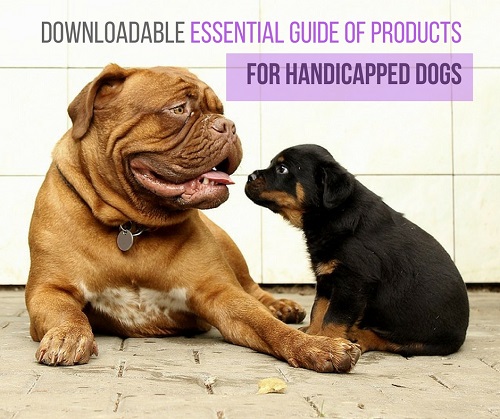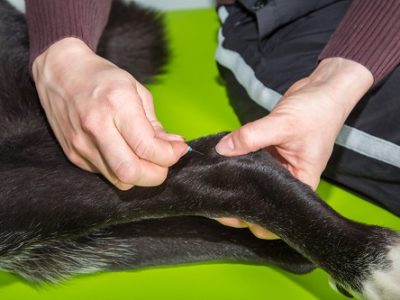
When a member of my Dog Wheelchair LIFE Facebook Group posted information about healing a dog wound with honey, interest in the topic went wild. Scrapes and cuts are a common problem for dogs with mobility problems and so are open wounds.
Dogs who have trouble walking, drag their legs on the floor and other hard surfaces. It causes sores, abrasions and burns.
The lack of sensations in their limbs also makes paralyzed dogs prone to pressure sores. Dogs lie on their hip and side for long periods of time, which breaks down the skin and causes a sore to develop.
Knowing there is an easy way to treat and heal these injuries with a natural product like honey is important.
Note: Be sure to check with your dog’s veterinarian before using honey on your individual pet.
Note: Some of the links in this article are affiliate links. As an Amazon Associate, I earn from qualifying purchases. Read our policy.

Ask & Discover
Get personalized content recommendations and answers drawn from our website. Simply type your question or topic of interest, and our AI assistant will help you find relevant articles, tips, and insights. You can also have a natural conversation to explore topics in more depth.
How honey heals a wound

Raw, natural honey has been used for centuries as a dressing for wounds in both humans and animals. It’s even safe for dogs to eat, in small quantities.
The reason for this continued use and love of honey is its many medicinal properties.
Honey contains these beneficial elements:
Antimicrobial – Honey has cells that eat up dead tissue and promote healing. It does this, in part, with sugar and an acidic pH level. Sugar pulls water away from a damaged area to help it die off and the pH releases oxygen into the blood for quick healing.
Antibacterial – Honey also contains properties that kill harmful bacteria. It can even ward off superbugs like MRSA (methicillin-resistant staphylococcus aureus) and VRE (vancomycin-resistant enterococcus).
Antiviral – Some honey, like Manuka, have antiviral elements that help regrow tissue. (We’ll talk more about this below.)
Antifungal – Because raw honey contains a natural form of the antiseptic, hydrogen peroxide, it has the ability to destroy fungus in an open wound.

eBook
Find The Right Dog Wheelchair For Your Pet
Your dog has a mobility problem, and you want to buy a wheelchair. But do you know what kind of cart will work best for your dog’s individual needs? After a decade of teaching pet owners how to make the right choice, I put the information into an eBook!
The type of skin injuries honey can heal
Here are the most common dog wounds where honey is used:
Cuts and scrapes to the limbs
Pressure sores on the hips, elbows and paws
Bacterial infections to the skin
Hot spots
Superficial burns, such as road burn from a dog dragging their body
Are all types of honey equal?

There are four grades of honey I want to address: Manuka, medical grade honey, raw, and processed honey.
Manuka honey
Manuka honey became the “gold standard” of honey, after a study was completed about it in 2015. The honey comes from bees that pollinate the white flowers of the Manuka tree and the Tea Tree bush that surrounds them, in New Zealand and Australia.
It was found to protect against 60 different types of bacteria. And its powerful chemicals were proven to have long-lasting antibiotic, antiviral and antifungal capabilities. The study also found that Manuka honey benefitted people (dogs were not part of the study) with a long list of ailments that range from: ulcers, respiratory infections, irritable bowel syndrome, sore throats, gum and tooth decay and antibiotic-resistant infections.
Manuka honey also goes through strict processing guidelines that includes: sterilization, testing for cross-contamination and checking the potency of the ingredients.
The only negatives to using Manuka honey is the risk of infant botulism to young children, possible allergic reactions and a caution to people with diabetes.
Medical grade honey
All honey, from any part of the world, can be given the status of medical grade. It’s raw honey that’s been sterilized with gamma irradiation. This is a safe technique that doesn’t change the elements of the honey or its health benefits. Medical grade honey is safe for babies to eat and packaged to protect the ingredients and potency.

Get the Essential Guide
The Essential Guide of Products for Handicapped Dogs e-book is a labor of love for me. I wrote it to answer your most pressing questions about where to find the best products for your wheelchair dog. You’ll find products you didn’t know existed and each will improve your dog’s quality of life. Print a copy and keep it by your side.
Raw honey
Raw honey is a natural product that’s unpasteurized and unfiltered. It’s honey that comes straight out of the hive. Fans like this type of honey because there are no added ingredients and it doesn’t go through a radiation process that could alter the product. Raw honey is typically sold fresh from local beekeepers and farmers.
Processed honey
This is the type of honey you find in a grocery store with a squeezable top. It’s been heated and processed through a filtration system to keep it clear and fresh and it’s the least expensive honey to buy. While this might make processed honey seem less appealing to use, a professional in veterinary medicine said it is still suitable to use, in a pinch, to heal a dog wound.
How to make a bandage with honey

Start by thoroughly washing your hands with warm water and soap. Have on hand a cotton tipped swab (Q-tip), honey, surgical tape, sterilized gauze or a Telfa Non-Adhesive Dressing. A Telfa pad will protect the wound, but won’t pull off the new skin when you remove it.
If the wound needs to be cleaned, gently wash it with warm water.
- Apply the honey to the dressing (pad), then apply the pad to the wound. Don’t rub the honey directly on the wound.
- Apply a second dry dressing pad over the first one so the honey doesn’t leak out.
- Use surgical tape, if needed, to keep the dressing in place.
- Change the dressing once or twice a day as prescribed by your veterinarian.
Want to read more about wound care?
Dog Compression Sleeve Protects Cuts, Scrapes and Wounds
Why Urine Scald in a Paralyzed Dog IS A Big Problem

My favorite harnesses for disabled dogs.
Products that heal wounds
Walkabout Canine Compression Sleeve
Dog Front Limb Compression Sleeve


![Depositphotos_talking-to-dog[1]](https://dogwheelchairlife.com/wp-content/uploads/2020/12/Depositphotos_talking-to-dog1-400x300.jpg)


Leave a Reply